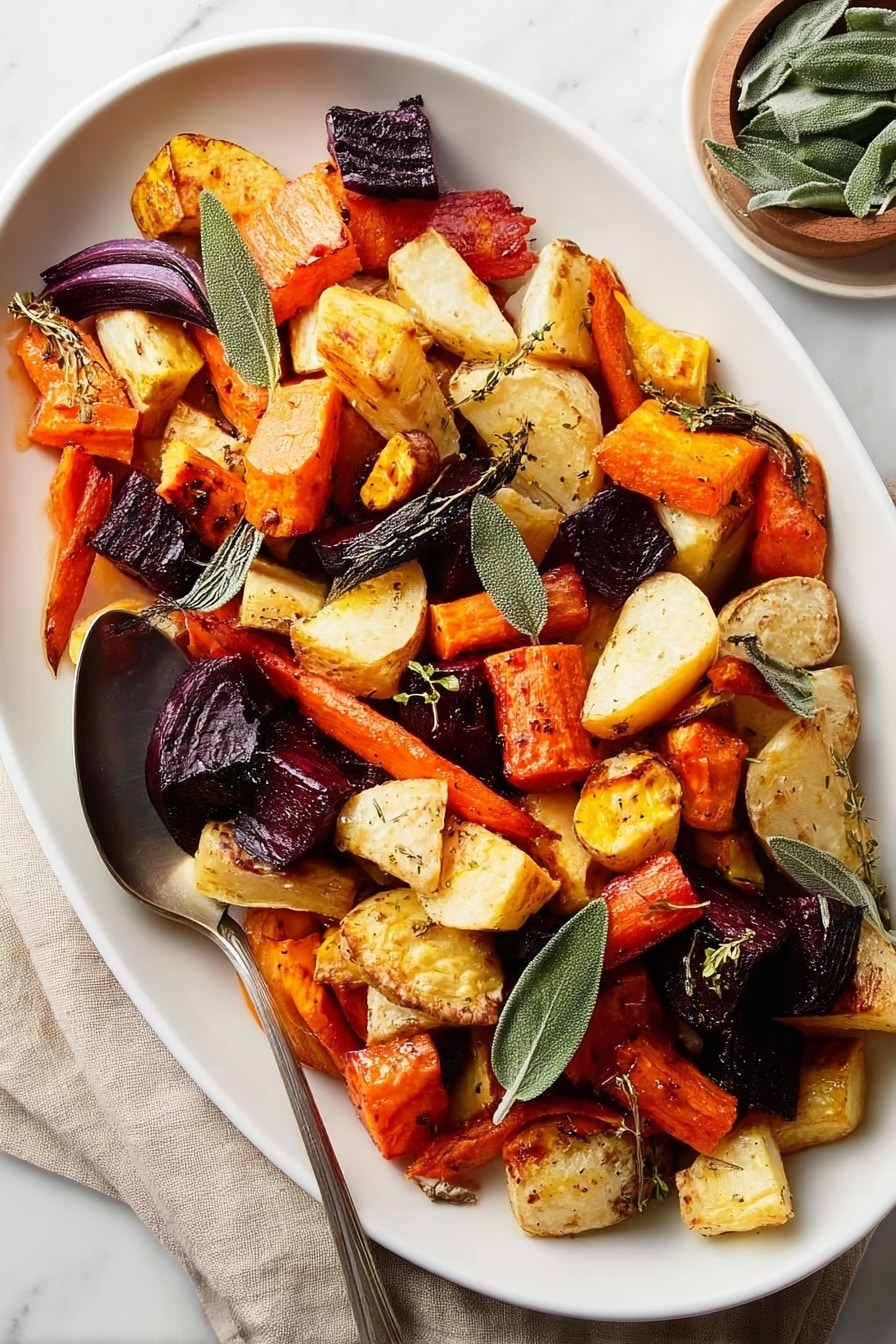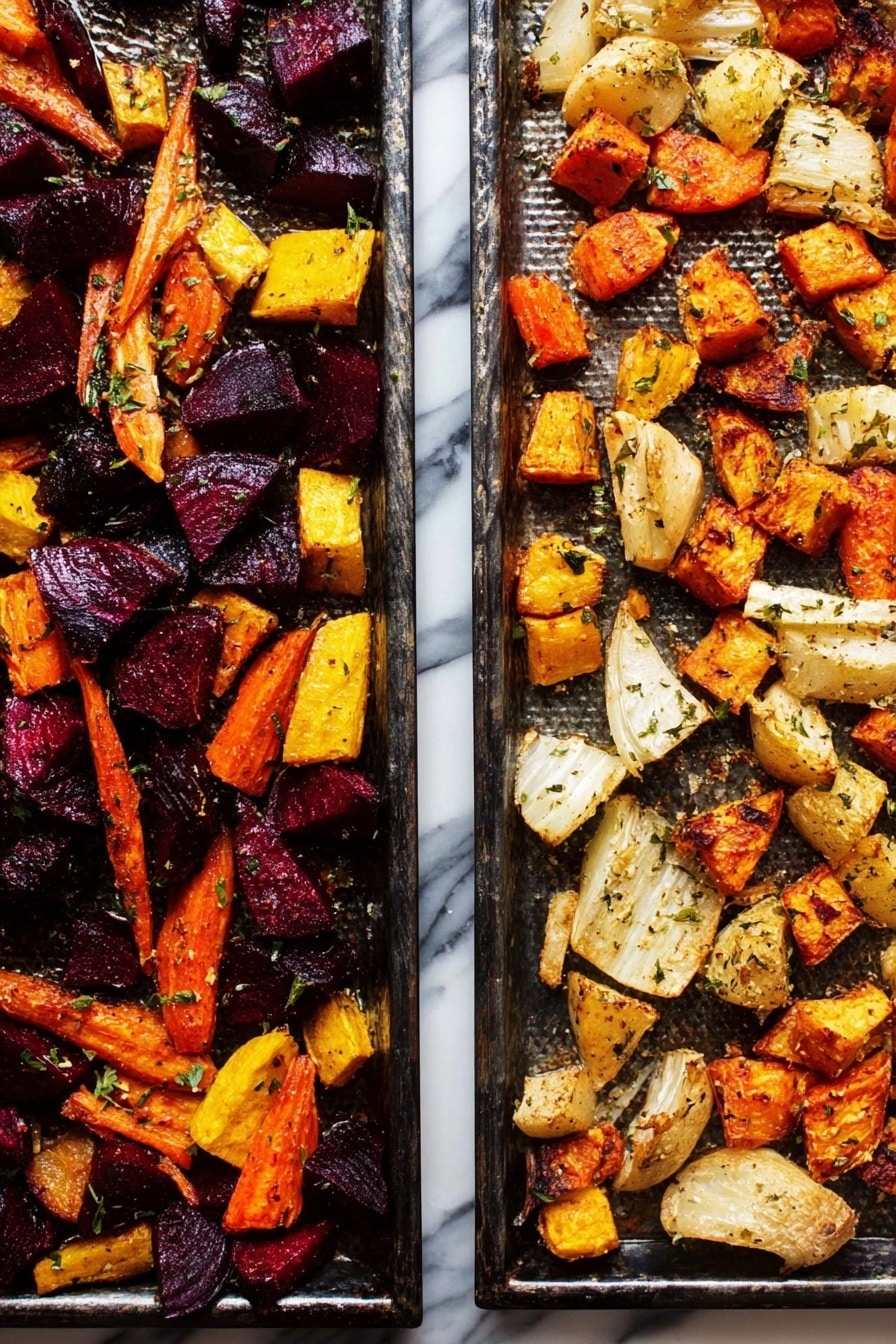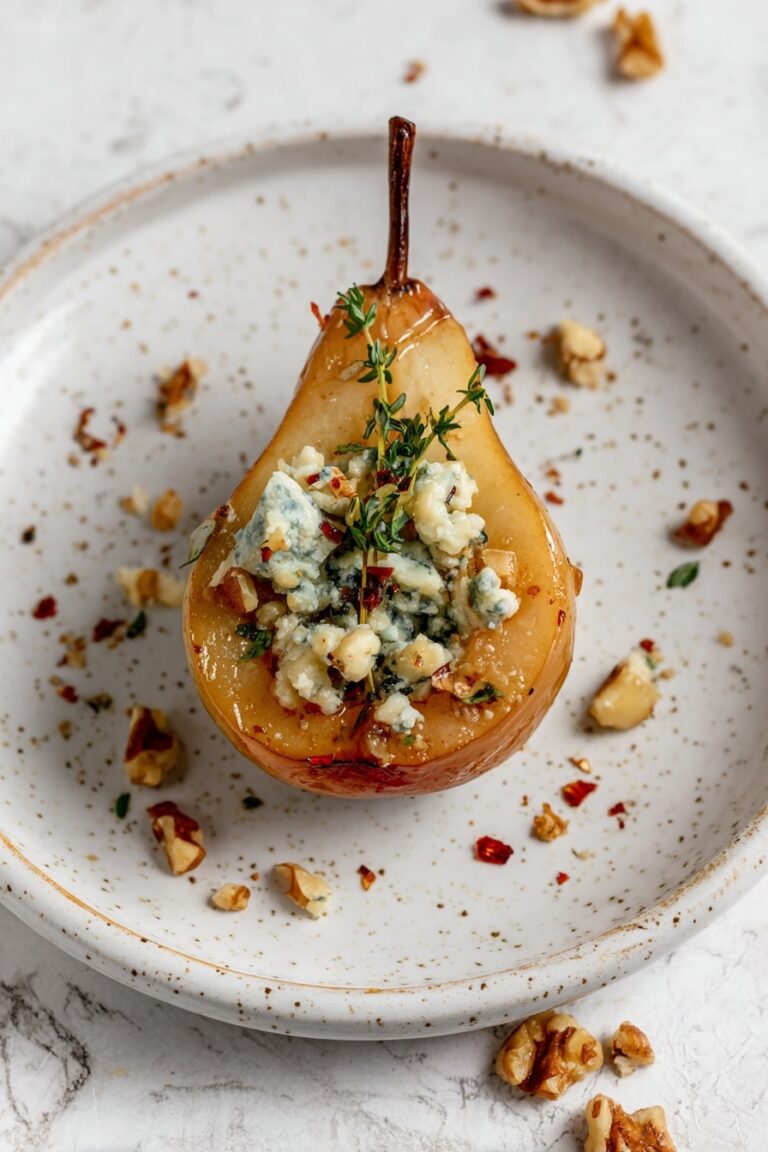Roasted Root Vegetables with Crispy Sage and Sage Oil Recipe
If you’re looking for a side dish that’s not only rustic and colorful but absolutely bursting with flavor, you’ve got to try my Roasted Root Vegetables with Crispy Sage and Sage Oil Recipe. This isn’t your average roasted veggie plate — it’s got that special something from fresh herbs and the magical crunch of crispy sage that makes every bite memorable. Plus, roasting brings out the natural sweetness and deep earthy tones of all these root vegetables. I promise, once you try this, it’ll be a staple in your cooking rotation.
Why This Recipe Works
- Layered Flavors: The combination of fresh rosemary, sage, and thyme creates a beautifully herbal aroma that elevates simple root vegetables.
- Perfect Texture Balance: Roasting caramelizes the veggies’ natural sugars while the crispy sage adds a satisfying crunch contrast.
- Colorful Variety: Using a mix of beets, carrots, parsnips, and more keeps things visually stunning and flavorful.
- Versatile and Easy: Minimal hands-on time, straightforward steps, and flexible ingredients make this a go-to side for any meal.
Ingredients & Why They Work
What I love about the ingredients in this Roasted Root Vegetables with Crispy Sage and Sage Oil Recipe is how each one plays a pivotal role in flavor and texture. I always recommend using fresh, firm root vegetables and plenty of fresh herbs to get the best results. When shopping, look for beets that feel heavy and carrots with vibrant skin. Fresh sage leaves are a must—dry sage just can’t replace that crispy magic.
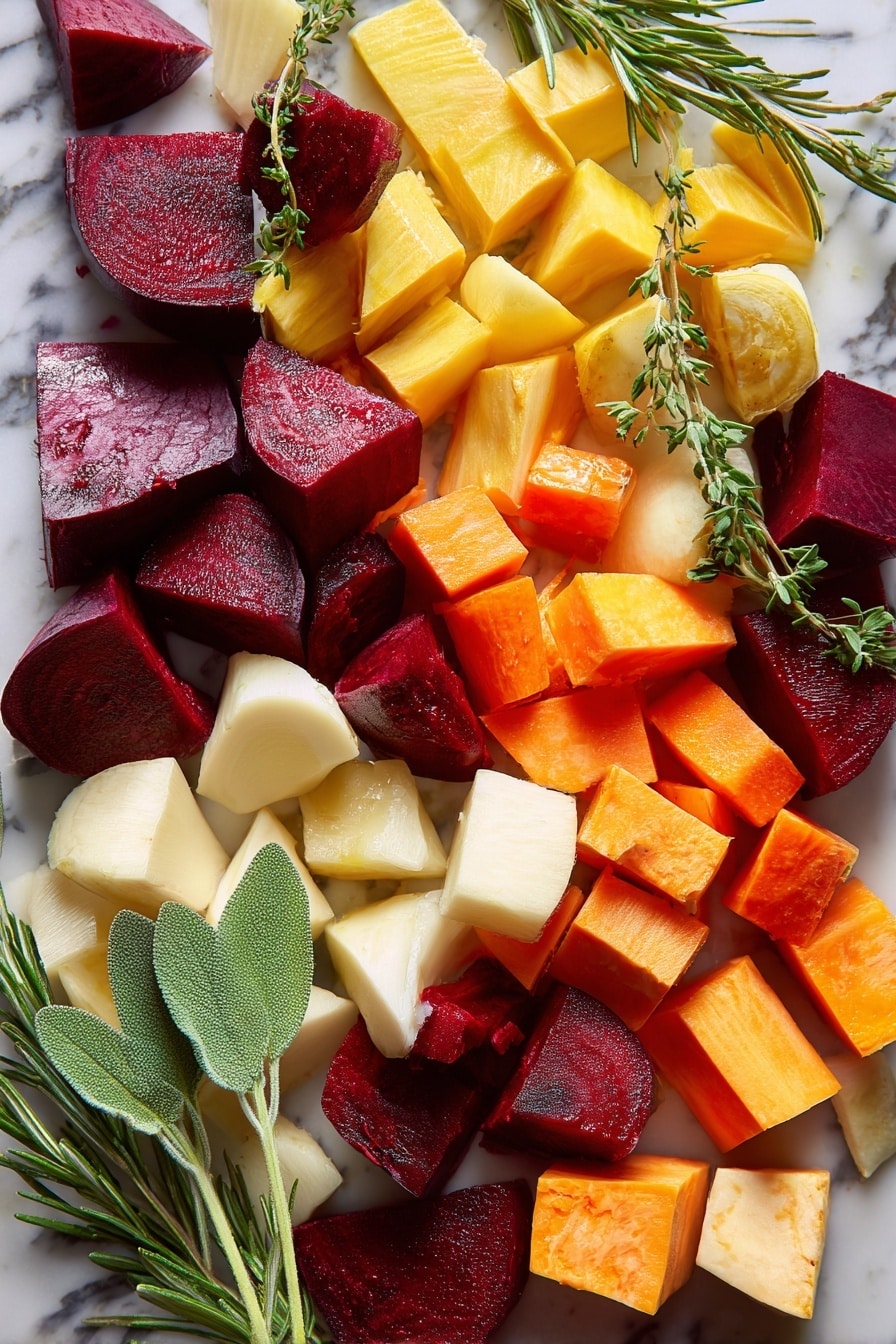
- Beets: Their earthy sweetness adds depth and that gorgeous pop of color—try both red and golden for visual interest.
- Carrots: Adds natural sweetness and tender crunch; roll-cut helps them cook evenly.
- Parsnips: Slightly nutty flavor and creamy texture, perfect roasted.
- Sweet Potato: Brings creaminess and caramelized notes that balance the other roots.
- Turnip: Adds a mild peppery bite and firmness to the mix.
- Fresh Rosemary: Woody herb that infuses the veggies with piney, fragrant notes.
- Fresh Sage Leaves: Key for the crispy sage topping and the infused sage oil that finishes the dish.
- Fresh Thyme Leaves: Adds subtle earthiness without overpowering the other herbs.
- Extra-Virgin Olive Oil: Helps everything roast beautifully and creates that delicious sage-infused oil.
- Sea Salt & Freshly Ground Black Pepper: Essential to season and bring out the natural flavors.
Make It Your Way
I love encouraging personalization in this Roasted Root Vegetables with Crispy Sage and Sage Oil Recipe. Once you get the basics down, feel free to mix up the root veg combo or swap out herbs to suit your mood or the season. It’s a forgiving recipe that’s fun to experiment with.
- Variation: I once added cubed rutabaga for a little more bite and it worked beautifully, adding a slightly peppery zing that balanced the sweetness.
- Dietary Modifications: For a dairy-free meal, this recipe is naturally perfect as-is, but you can also add a drizzle of balsamic glaze to deepen the flavor.
- Seasonal Changes: Switch up herbs with what you have on hand—thyme and rosemary are great fall/winter herbs, but summer herbs like oregano or marjoram can freshen things up.
Step-by-Step: How I Make Roasted Root Vegetables with Crispy Sage and Sage Oil Recipe
Step 1: Prep the Vegetables With Purpose
The first thing I do is peel and chop all the root veggies into 1-inch chunks. This size ensures even roasting and that perfect balance between a tender inside and slightly caramelized edges. I like to peel beets carefully—use a vegetable peeler or just slip off the skins after roasting if you want to save time. For carrots, I do a roll cut—it helps the pieces cook evenly and look prettier on the plate. I split the veggies onto two baking sheets because beets and carrots need a bit more roasting time than the others.
Step 2: Herb-Infused Oven Magic
Drizzle the vegetables generously with extra-virgin olive oil—don’t be shy here; it really helps with caramelization and keeps them moist. Sprinkle chopped fresh rosemary, sage, fresh thyme leaves, salt, and pepper over everything. Then toss it all together right on the baking sheet to ensure every piece is lovingly coated. Roast at 425°F, keeping the beets and carrots in the oven longer (about 50 minutes) while the other veggies are done in roughly 25 minutes. You’ll know they’re ready when the edges brown and a fork slides in easily.
Step 3: The Crispy Sage and Sage Oil Finale
While the veggies are roasting, it’s time to get your sage crispy. Heat 2 tablespoons of olive oil in a small saucepan until shimmering, then add your fresh sage leaves. Stir them gently and watch closely—they crisp up in about 1 minute. Remove the sage leaves onto a paper towel-lined plate to drain, but don’t toss that oil! That sage-infused oil is the secret sauce that you’ll drizzle over your roasted veggies for an extra layer of flavor and aroma.
Step 4: Serve and Impress
Once your vegetables are beautifully roasted, toss them with a tablespoon of your reserved sage oil. Transfer to a serving platter and top with those crispy golden sage leaves. The combination of warm, tender veggies and that irresistible crunch will wow anyone lucky enough to try it.
Tips from My Kitchen
- Even Cooking: Cutting all vegetables roughly the same size ensures no one gets overly mushy or burnt.
- Herb Freshness: I learned fresh herbs make all the difference—avoid dried sage if you want those vibrant flavors and texture.
- Oil Hotness: Heat the oil just until bubbly to get quick crisping without burning the sage leaves.
- Don’t Overcrowd: Giving the vegetables space on the baking sheet helps them roast instead of steam.
How to Serve Roasted Root Vegetables with Crispy Sage and Sage Oil Recipe
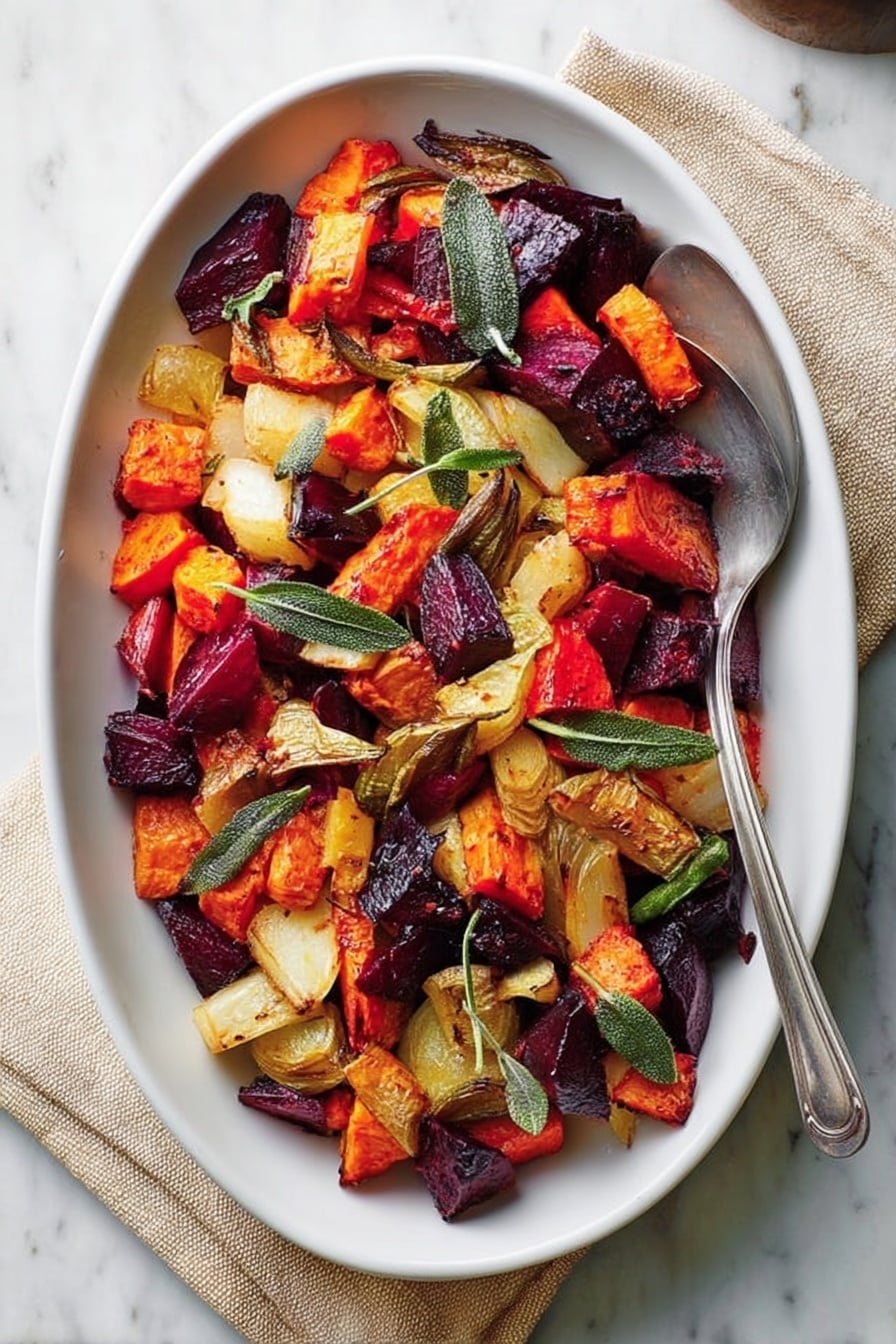
Garnishes
I often add a sprinkle of flaky sea salt right before serving to give a little crunch and enhance the flavors. A few extra sage leaves or even a light drizzle of balsamic glaze can also elevate the presentation and taste beautifully. Sometimes I throw on a handful of toasted pine nuts for a nutty contrast — it’s a little trick I picked up that guests seem to love.
Side Dishes
This recipe pairs incredibly well with roast chicken or pork, but I’ve also enjoyed it alongside creamy polenta or a bed of wild rice. For a vegetarian meal, serve it with warm crusty bread and a tangy salad dressed with lemon vinaigrette to balance the richness.
Creative Ways to Present
For holiday dinners or special occasions, I like to arrange the roasted root vegetables in a large wooden bowl or rustic platter and top with the crispy sage artfully scattered on top. Adding edible flowers or microgreens can brighten up the dish visually. You can even roast the vegetables in smaller ramekins for individual servings — it feels like a little surprise for each guest.
Make Ahead and Storage
Storing Leftovers
I store leftovers in an airtight container in the fridge and they keep beautifully for up to 3 days. The flavors actually deepen overnight, but make sure you add the crispy sage fresh if possible, since it loses its crunch.
Freezing
I’ve frozen roasted root vegetables before, but I recommend freezing them without the crispy sage topping. Freeze in a single layer first, then transfer to a freezer bag. When reheated, the texture is pretty good, but the crispy sage is best made fresh for maximum crunch.
Reheating
To bring leftovers back to life, I reheat them in a 375°F oven for about 10-15 minutes to keep the edges a little crisp. Microwave works in a pinch, but you might lose some texture. Then, I toss with a little fresh sage oil or olive oil to refresh the flavor. Adding crispy sage fresh on top finishes things perfectly.
FAQs
-
Can I use dried sage instead of fresh?
For the crispy sage topping and infused oil, fresh sage leaves are essential. Dried sage won’t crisp up properly and doesn’t have the same vibrant flavor. However, you can use dried sage in the herb mix for seasoning the vegetables if fresh isn’t available.
-
What if I don’t have all the root vegetables listed?
No worries! This recipe is very flexible. Use whatever root vegetables you have on hand—sweet potatoes, parsnips, carrots, beets, turnips, rutabagas, or even potatoes all work well. Just adjust roasting times based on the density of each vegetable.
-
How do I know when the vegetables are perfectly roasted?
Look for tender veggies when pierced with a fork and edges that are nicely browned and caramelized without burning. The scent will be fragrant and sweet, signaling that the sugars have caramelized.
-
Can I prepare the sage oil in advance?
Absolutely! You can make sage oil a day ahead and store it in the fridge. Just gently reheat before drizzling over the vegetables, and crisp the sage leaves fresh to maintain their crunch.
Final Thoughts
Honestly, this Roasted Root Vegetables with Crispy Sage and Sage Oil Recipe has become one of my go-to dishes anytime I want to impress with something simple yet unforgettable. It’s one of those recipes that fills the kitchen with the most comforting aromas and scores all the compliments without much fuss. Give it a try—you’ll find it’s not only easy but also a real crowd-pleaser that brings so much warmth and flavor to your table. I’m already thinking about my next batch!
Print
Roasted Root Vegetables with Crispy Sage and Sage Oil Recipe
- Prep Time: 15 minutes
- Cook Time: 45 minutes
- Total Time: 1 hour
- Yield: 6 servings
- Category: Side Dish
- Method: Roasting
- Cuisine: American
- Diet: Vegetarian
Description
A vibrant and flavorful medley of roasted root vegetables, enhanced with fresh herbs and topped with crispy sage leaves for a perfect side dish.
Ingredients
Roasted Root Vegetables
- 2 beets, preferably 1 red and 1 golden, peeled and chopped into 1-inch chunks
- 1 large carrot, roll cut into 1-inch chunks
- 3 parsnips, chopped into 1-inch chunks
- 1 medium sweet potato, chopped into 1-inch chunks
- 1 turnip, chopped into 1-inch chunks
- Extra-virgin olive oil, for drizzling
- 1 tablespoon chopped fresh rosemary
- 1 tablespoon chopped fresh sage leaves
- 1 tablespoon fresh thyme leaves
- Sea salt, to taste
- Freshly ground black pepper, to taste
Crispy Sage and Sage Oil
- 2 tablespoons extra-virgin olive oil
- 10 fresh sage leaves
Instructions
- Preheat Oven: Preheat the oven to 425°F and line two baking sheets with parchment paper to ensure even roasting and easy cleanup.
- Prepare Vegetables: Place the beets and carrots on one baking sheet and the parsnips, sweet potato, and turnip on the other. Drizzle all vegetables generously with extra-virgin olive oil.
- Season: Sprinkle the rosemary, sage, thyme, sea salt, and freshly ground black pepper over the vegetables. Toss each batch well to evenly coat all pieces with the oil and herbs, then spread them out evenly on the baking sheets.
- Roast Vegetables: Roast the vegetables in the preheated oven for 45 minutes, checking for tenderness and browning around the edges. The parsnips, sweet potato, and turnip will cook slightly faster, so you can remove them earlier if desired, while the beets and carrots will need longer to become tender and caramelized.
- Make Crispy Sage: While the vegetables roast, line a plate with paper towels. Heat 2 tablespoons extra-virgin olive oil in a small saucepan over medium heat until it begins bubbling. Add the 10 fresh sage leaves and stir them, cooking until crisp, approximately 1 minute. Remove the sage leaves with a slotted spoon and drain on the paper towels, reserving the sage oil.
- Toss and Serve: Once the vegetables are roasted, remove them from the oven and toss them with 1 tablespoon of the reserved sage oil to add extra flavor and aroma. Transfer the vegetables to a serving platter and top with the crispy sage leaves for garnish and a delightful crunch.
Notes
- For uniform cooking, cut all vegetables into similar sized chunks, approximately 1 inch each.
- If you prefer a more caramelized flavor, you can roast the vegetables for up to 50 minutes, checking occasionally to avoid burning.
- Use parchment paper on baking sheets to prevent sticking and ease cleanup.
- Leftover roasted vegetables can be stored in an airtight container for up to 3 days and reheated in the oven.
- You can substitute fresh herbs with dried ones, but reduce the quantity by half as dried herbs are more concentrated.
Nutrition
- Serving Size: 1 cup
- Calories: 150 kcal
- Sugar: 7 g
- Sodium: 140 mg
- Fat: 7 g
- Saturated Fat: 1 g
- Unsaturated Fat: 6 g
- Trans Fat: 0 g
- Carbohydrates: 20 g
- Fiber: 5 g
- Protein: 2 g
- Cholesterol: 0 mg

